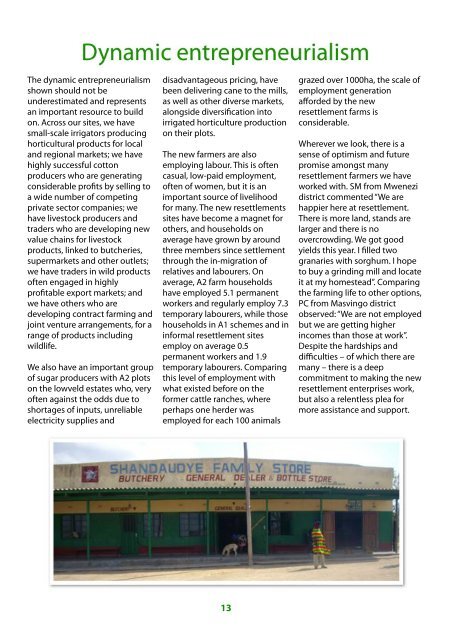Zimbabwe's Land Reform
Zimbabwe's Land Reform
Zimbabwe's Land Reform
Create successful ePaper yourself
Turn your PDF publications into a flip-book with our unique Google optimized e-Paper software.
The dynamic entrepreneurialism<br />
shown should not be<br />
underestimated and represents<br />
an important resource to build<br />
on. Across our sites, we have<br />
small-scale irrigators producing<br />
horticultural products for local<br />
and regional markets; we have<br />
highly successful cotton<br />
producers who are generating<br />
considerable profits by selling to<br />
a wide number of competing<br />
private sector companies; we<br />
have livestock producers and<br />
traders who are developing new<br />
value chains for livestock<br />
products, linked to butcheries,<br />
supermarkets and other outlets;<br />
we have traders in wild products<br />
often engaged in highly<br />
profitable export markets; and<br />
we have others who are<br />
developing contract farming and<br />
joint venture arrangements, for a<br />
range of products including<br />
wildlife.<br />
We also have an important group<br />
of sugar producers with A2 plots<br />
on the lowveld estates who, very<br />
often against the odds due to<br />
shortages of inputs, unreliable<br />
electricity supplies and<br />
disadvantageous pricing, have<br />
been delivering cane to the mills,<br />
as well as other diverse markets,<br />
alongside diversification into<br />
irrigated horticulture production<br />
on their plots.<br />
The new farmers are also<br />
employing labour. This is often<br />
casual, low-paid employment,<br />
often of women, but it is an<br />
important source of livelihood<br />
for many. The new resettlements<br />
sites have become a magnet for<br />
others, and households on<br />
average have grown by around<br />
three members since settlement<br />
through the in-migration of<br />
relatives and labourers. On<br />
average, A2 farm households<br />
have employed 5.1 permanent<br />
workers and regularly employ 7.3<br />
temporary labourers, while those<br />
households in A1 schemes and in<br />
informal resettlement sites<br />
employ on average 0.5<br />
permanent workers and 1.9<br />
temporary labourers. Comparing<br />
this level of employment with<br />
what existed before on the<br />
former cattle ranches, where<br />
perhaps one herder was<br />
employed for each 100 animals<br />
grazed over 1000ha, the scale of<br />
employment generation<br />
afforded by the new<br />
resettlement farms is<br />
considerable.<br />
Wherever we look, there is a<br />
sense of optimism and future<br />
promise amongst many<br />
resettlement farmers we have<br />
worked with. SM from Mwenezi<br />
district commented “We are<br />
happier here at resettlement.<br />
There is more land, stands are<br />
larger and there is no<br />
overcrowding. We got good<br />
yields this year. I filled two<br />
granaries with sorghum. I hope<br />
to buy a grinding mill and locate<br />
it at my homestead”. Comparing<br />
the farming life to other options,<br />
PC from Masvingo district<br />
observed: “We are not employed<br />
but we are getting higher<br />
incomes than those at work”.<br />
Despite the hardships and<br />
difficulties – of which there are<br />
many – there is a deep<br />
commitment to making the new<br />
resettlement enterprises work,<br />
but also a relentless plea for<br />
more assistance and support.<br />
13

















